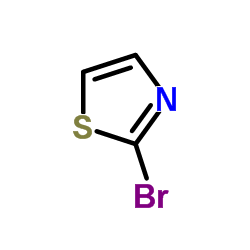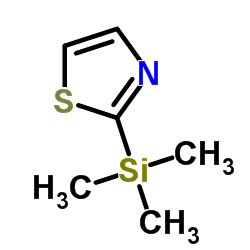121359-48-6
| Name | tributyl(1,3-thiazol-2-yl)stannane |
|---|---|
| Synonyms |
2-(Tributylstannyl)-1,3-thiazole
tributylstannylthiazole 2-tributylstannanyl-thiazole 2-(1,1,1-tributylstannyl)-1,3-thiazole 2-(Tributylstannyl)thiazole 2-(tri-n-butylstannyl)thiazole Thiazole, 2-(tributylstannyl)- thiazole-2-SnBu3 2-(tributylstannanyl)-1,3-thiazole MFCD01319057 Thiazole,2-(tributylstannyl) (1,3-Thiazol-2-yl)tributylstannane |
| Density | 1.1900 g/mL at 25ºC(lit.) |
|---|---|
| Boiling Point | 361.7±25.0 °C at 760 mmHg |
| Melting Point | 307-309ºC(lit.) |
| Molecular Formula | C15H29NSSn |
| Molecular Weight | 374.172 |
| Flash Point | 172.6±23.2 °C |
| Exact Mass | 375.104279 |
| PSA | 41.13000 |
| LogP | 9.19 |
| Vapour Pressure | 0.0±0.8 mmHg at 25°C |
| Index of Refraction | n20/D 1.5200(lit.) |
| Storage condition | 2~8℃ |
|
Section1. IDENTIFICATION OF THE SUBSTANCE/MIXTURE Product name: 2-Tributylstannylthiazole Section2. HAZARDS IDENTIFICATION Classification of the substance or mixture According to Regulation (EC) No1272/2008 Acute toxicity, Dermal (Category 4) Acute toxicity, Oral (Category 3)
Skin irritation (Category 2) Eye irritation (Category 2) Specific target organ toxicity - repeated exposure (Category 1) Acute aquatic toxicity (Category 1) According to European Directive 67/548/EEC as amended. Toxic if swallowed. Toxic: danger of serious damage to health by prolonged exposure through inhalation and if swallowed. Harmful in contact with skin. Irritating to eyes and skin. Very toxic to aquatic organisms, may cause long-term adverse effects in the aquatic environment. Label elements Pictogram Signal wordDanger Hazard statement(s) H301Toxic if swallowed. H312Harmful in contact with skin. H315Causes skin irritation. H319Causes serious eye irritation. H372Causes damage to organs through prolonged or repeated exposure. H400Very toxic to aquatic life. Precautionary statement(s) P273Avoid release to the environment. P280Wear protective gloves/protective clothing. P301 + P310IF SWALLOWED: Immediately call a POISON CENTER or doctor/physician. P305 + P351 + P338IF IN EYES: Rinse cautiously with water for several minutes. Remove contact lenses, if present and easy to do. Continue rinsing. P314Get medical advice/attention if you feel unwell. Hazard symbol(s) TToxic NDangerous for the environment R-phrase(s) R21Harmful in contact with skin. R25Toxic if swallowed. R36/38Irritating to eyes and skin. R48/23/25Toxic: danger of serious damage to health by prolonged exposure through inhalation and if swallowed. R50/53Very toxic to aquatic organisms, may cause long-term adverse effects in the aquatic environment. S-phrase(s) S35This material and its container must be disposed of in a safe way. S36/37/39Wear suitable protective clothing, gloves and eye/face protection. S45In case of accident or if you feel unwell, seek medical advice immediately (show the label where possible). S60This material and its container must be disposed of as hazardous waste. S61Avoid release to the environment. Refer to special instructions/ Safety data sheets. Other hazards - none Section3. COMPOSITION/INFORMATION ON INGREDIENTS Formula: C15H29NSSn Molecular Weight: 374,17 g/mol CAS-No.EC-No.Index-No.ClassificationConcentration 2-Tributylstannylthiazole 121359-48-6-050-008-00-3Acute Tox. 4; Acute Tox. 3;- Skin Irrit. 2; Eye Irrit. 2; STOT RE 1; Aquatic Acute 1; H301, H312, H315, H319, H372, H400 T, N, R21 - R25 - R36/38 - R48/23/25 - R50/53 For the full text of the H-Statements mentioned in this Section, see Section 16. Section4. FIRST AID MEASURES General advice Consult a physician. Show this safety data sheet to the doctor in attendance. If inhaled If breathed in, move person into fresh air. If not breathing give artificial respiration Consult a physician. In case of skin contact Wash off with soap and plenty of water. Consult a physician. In case of eye contact Rinse thoroughly with plenty of water for at least 15 minutes and consult a physician. If swallowed Never give anything by mouth to an unconscious person. Rinse mouth with water. Consult a physician. Section5. FIRE-FIGHTING MEASURES Suitable extinguishing media Use water spray, alcohol-resistant foam, dry chemical or carbon dioxide. Special protective equipment for fire-fighters Wear self contained breathing apparatus for fire fighting if necessary. Section6. ACCIDENTAL RELEASE MEASURES Personal precautions Use personal protective equipment. Avoid breathing vapors, mist or gas. Ensure adequate ventilation. Evacuate personnel to safe areas. Environmental precautions Prevent further leakage or spillage if safe to do so. Do not let product enter drains. Discharge into the environment must be avoided. Methods and materials for containment and cleaning up Soak up with inert absorbent material and dispose of as hazardous waste. Keep in suitable, closed containers for disposal. Section7. HANDLING AND STORAGE Precautions for safe handling Avoid contact with skin and eyes. Avoid inhalation of vapour or mist. Normal measures for preventive fire protection. Conditions for safe storage Store in cool place. Keep container tightly closed in a dry and well-ventilated place. Containers which are opened must be carefully resealed and kept upright to prevent leakage. Section8. EXPOSURE CONTROLS/PERSONAL PROTECTION Personal protective equipment Respiratory protection Where risk assessment shows air-purifying respirators are appropriate use a full-face respirator with multi-purpose combination (US) or type ABEK (EN 14387) respirator cartridges as a backup to engineering controls. If the respirator is the sole means of protection, use a full-face supplied air respirator. Use respirators and components tested and approved under appropriate government standards such as NIOSH (US) or CEN (EU). Hand protection The selected protective gloves have to satisfy the specifications of EU Directive 89/686/EEC and the standard EN 374 derived from it. Handle with gloves. Eye protection Face shield and safety glasses Skin and body protection Choose body protection according to the amount and concentration of the dangerous substance at the work place. Hygiene measures Avoid contact with skin, eyes and clothing. Wash hands before breaks and immediately after handling the product. Section9. PHYSICAL AND CHEMICAL PROPERTIES Appearance Formliquid Colourcolourless Safety data pHno data available Melting pointno data available Boiling point307 - 309 °C - lit. Flash point> 110 °C - closed cup Ignition temperatureno data available Lower explosion limitno data available Upper explosion limitno data available Density1,19 g/cm3 at 25 °C Water solubilityno data available Section10. STABILITY AND REACTIVITY Chemical stability Stable under recommended storage conditions. Conditions to avoid no data available Materials to avoid Strong oxidizing agentsStrong oxidizing agents, Strong mineral acids, Bases Hazardous decomposition products Hazardous decomposition products formed under fire conditions. - Carbon oxides, nitrogen oxides (NOx), Sulphur oxides, Tin/tin oxides Section11. TOXICOLOGICAL INFORMATION Acute toxicity no data available Skin corrosion/irritation no data available Serious eye damage/eye irritation no data available Respiratory or skin sensitization no data available Germ cell mutagenicity no data available Carcinogenicity IARC: No component of this product present at levels greater than or equal to 0.1% is identified as probable, possible or confirmed human carcinogen by IARC. Reproductive toxicity no data available Specific target organ toxicity - single exposure no data available Specific target organ toxicity - repeated exposure Causes damage to organs through prolonged or repeated exposure. Aspiration hazard no data available Potential health effects InhalationToxic if inhaled. May cause respiratory tract irritation. IngestionToxic if swallowed. Skin Harmful if absorbed through skin. Causes skin irritation. EyesCauses eye irritation. Signs and Symptoms of Exposure To the best of our knowledge, the chemical, physical, and toxicological properties have not been thoroughly investigated. Additional Information RTECS: no data available Section12. ECOLOGICAL INFORMATION Toxicity no data available Persistence and degradability no data available Bioaccumulative potential no data available Mobility in soil no data available PBT and vPvB assessment no data available Other adverse effects Very toxic to aquatic organisms, may cause long-term adverse effects in the aquatic environment. Section13. DISPOSAL CONSIDERATIONS Product Observe all federal, state, and local environmental regulations. Contact a licensed professional waste disposal service to dispose of this material. Dissolve or mix the material with a combustible solvent and burn in a chemical incinerator equipped with an afterburner and scrubber. Contaminated packaging Dispose of as unused product. Section14. TRANSPORT INFORMATION ADR/RID UN-Number: 2788 Class: 6.1Packing group: II Proper shipping name: ORGANOTIN COMPOUND, LIQUID, N.O.S. (2-Tributylstannylthiazole) IMDG UN-Number: 2788 Class: 6.1Packing group: IIEMS-No: F-A, S-A Proper shipping name: ORGANOTIN COMPOUND, LIQUID, N.O.S. (2-Tributylstannylthiazole) Marine pollutant: Marine pollutant IATA UN-Number: 2788 Class: 6.1Packing group: II Proper shipping name: Organotin compound, liquid, n.o.s. (2-Tributylstannylthiazole) Section15. REGULATORY INFORMATION This safety datasheet complies with the requirements of Regulation (EC) No. 1907/2006. Section16. OTHER INFORMATION Text of H-code(s) and R-phrase(s) mentioned in Section 3 Acute Tox.Acute toxicity Aquatic AcuteAcute aquatic toxicity Eye Irrit.Eye irritation H301Toxic if swallowed. H312Harmful in contact with skin. H315Causes skin irritation. H319Causes serious eye irritation. H372Causes damage to organs through prolonged or repeated exposure. H400Very toxic to aquatic life. Skin Irrit.Skin irritation STOT RESpecific target organ toxicity - repeated exposure NDangerous for the environment TToxic R21Harmful in contact with skin. R25Toxic if swallowed. R36/38Irritating to eyes and skin. R48/23/25Toxic: danger of serious damage to health by prolonged exposure through inhalation and if swallowed. R50/53Very toxic to aquatic organisms, may cause long-term adverse effects in the aquatic environment. Further information Copyright 2010 Co. License granted to make unlimited paper copies for internal use only. The above information is believed to be correct but does not purport to be all inclusive and shall be used only as a guide. The information in this document is based on the present state of our knowledge and is applicable to the product with regard to appropriate safety precautions. It does not represent any guarantee of the properties of the product. Co., shall not be held liable for any damage resulting from handling or from contact with the above product. See reverse side of invoice or packing slip for additional terms and conditions of sale. |
| Symbol |



GHS06, GHS08, GHS09 |
|---|---|
| Signal Word | Danger |
| Hazard Statements | H301-H312-H315-H319-H372-H400 |
| Precautionary Statements | P273-P280-P301 + P310-P305 + P351 + P338-P314 |
| Personal Protective Equipment | Eyeshields;Faceshields;full-face respirator (US);Gloves;multi-purpose combination respirator cartridge (US);type ABEK (EN14387) respirator filter |
| Hazard Codes | T: Toxic;N: Dangerous for the environment; |
| Risk Phrases | R21 |
| Safety Phrases | 35-36/37/39-45-60-61 |
| RIDADR | UN 2788 6.1/PG 2 |
| HS Code | 2934100090 |
|
~98% 
121359-48-6 |
| Literature: King Abdulaziz City for Science and Technology; Karim, Mohammad Rezaul; Akhtaruzzaman, Md.; Islam, Ashraful; Al-Ahmari, Abdulrahman M. Patent: US8575355 B2, 2013 ; Location in patent: Paragraph 0032 ; |
|
~97% 
121359-48-6 |
| Literature: ELAN PHARMACEUTICALS, INC.; GALEMMO, Robert, A., Jr.; ARTIS, Dean, Richard; YE, Xiaocong, Michael; AUBELE, Danielle, L.; TRUONG, Anh, P.; BOWERS, Simeon; HOM, Roy, K.; ZHU, Yong-Liang; NEITZ, R., Jeffrey; SEALY, Jennifer; ADLER, Marc; BEROZA, Paul; ANDERSON, John, P. Patent: WO2011/79114 A1, 2011 ; Location in patent: Page/Page column 125 ; WO 2011/079114 A1 |
|
~% 
121359-48-6 |
| Literature: WO2003/87104 A1, ; Page/Page column 14 ; WO 03/087104 A1 |
| Precursor 3 | |
|---|---|
| DownStream 0 | |
| HS Code | 2934100090 |
|---|---|
| Summary | 2934100090 other compounds containing an unfused thiazole ring (whether or not hydrogenated) in the structure VAT:17.0% Tax rebate rate:9.0% Supervision conditions:none MFN tariff:6.5% General tariff:20.0% |



